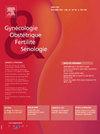[使用胎儿医学基金会算法筛查和预防子痫前期]。
IF 0.6
4区 医学
Q4 OBSTETRICS & GYNECOLOGY
引用次数: 0
摘要
目的:胎儿医学基金会(Fetal Medicine Foundation,FMF)建议,为了识别先兆子痫的高危产妇并为她们提供阿司匹林预防性治疗,应进行产前筛查。常用的阿司匹林用药阈值是风险>1/100,这意味着要治疗大量患者。我们的目的是评估这一策略在更严格的阈值(风险>1/70)下的使用情况,并评估这一策略对无先兆子痫妇女中先兆子痫合并早产患病率的影响:方法:2014年9月1日至2018年12月1日期间进行的前后队列研究,包括在图卢兹大学医院接受第一胎超声检查的无先兆子痫妇女。2014年9月9日至2016年9月9日期间("前队列"),妇女未接受子痫前期筛查。在2017年1月至2018年12月期间("后队列"),妇女使用FMF算法接受了有针对性的子痫前期筛查,风险>1/70的妇女接受了100毫克阿司匹林治疗。主要结果是先兆子痫合并早产。考虑到潜在的混杂因素,研究人员先进行了单变量分析,然后进行了多变量分析:在治疗前队列的 1030 名妇女中,有 17 名妇女(1.7%)出现先兆子痫并早产,而在治疗后队列的 629 名妇女中,有 8 名妇女(1.3%)出现先兆子痫并早产,两组间无显著差异(调整后奇数比 (95%CI) = 0.73 [0.31-1.74])。在后队列中,有 18 名妇女(2.9%)的风险大于 1/70,因此接受了阿司匹林治疗。根据 FMF 筛查测试,89 名妇女(14.1%)的风险大于 1/100,这是通常开具阿司匹林预防处方的阈值。这意味着有 71 名妇女的风险大于 1/100,但小于 1/70,因此在本研究中没有接受阿司匹林治疗,尽管按照通常的阈值,她们本应接受阿司匹林治疗:结论:采用限制性阈值的子痫前期筛查和预防策略并未降低子痫前期合并早产的发生率。本文章由计算机程序翻译,如有差异,请以英文原文为准。
Dépistage et prévention de la prééclampsie par l’algorithme de la Fetal Medicine Foundation : une étude avant-après
Objective
In order to identify women at high risk of pre-eclampsia and offer them aspirin prophylactic treatment, the Fetal Medicine Foundation (FMF) recommends a first-trimester screening test. The commonly used threshold for aspirin administration is a risk > 1/100, which implies treating an important number of patients. We aimed to assess the use of this strategy with a more restrictive threshold: risk > 1/70 and evaluate the impact of this strategy on the prevalence of pre-eclampsia with premature delivery in nulliparous women.
Methods
A before-and-after cohort study conducted from 01/09/2014 to 01/12/2018, including nulliparous women undergoing first-trimester ultrasound at the University Hospital of Toulouse. Between 09/2014 and 09/2016 (“before cohort”), women did not undergo pre-eclampsia screening. Between 01/2017 and 12/2018 (“after cohort”), women underwent targeted pre-eclampsia screening using the FMF algorithm, and those with a risk >1/70 received 100 mg aspirin. The primary outcome was pre-eclampsia with premature delivery. A univariate and then a multivariate analysis were performed to take into account potential confounding factors.
Results
Among the 1030 women of the before cohort, 17 women (1.7%) experienced pre-eclampsia with premature delivery, compared to 8 women (1.3%) among the 629 of the after cohort, with no significant difference between the two groups (Adjusted Odd Ratio (95%CI) = 0.73 [0.31–1.74]). In the after cohort, 18 women (2.9%) had a risk greater than 1/70 and therefore received aspirin. According to the FMF screening test, 89 women (14.1%) had a risk > 1/100, which is the usual threshold for prescribing aspirin for prophylaxis. This means that 71 women had a risk greater than 1/100 but less than 1/70 and therefore did not receive aspirin in this study, even though they would have received aspirin at the usual threshold.
Conclusions
The screening and prevention strategy for pre-eclampsia using restrictive thresholds did not decrease the rate of preeclampsia with premature delivery.
求助全文
通过发布文献求助,成功后即可免费获取论文全文。
去求助
来源期刊

Gynecologie Obstetrique Fertilite & Senologie
Medicine-Obstetrics and Gynecology
CiteScore
1.70
自引率
0.00%
发文量
170
期刊介绍:
Gynécologie Obstétrique Fertilité & Sénologie est un mensuel scientifique d''information et de formation destiné aux gynécologues, aux obstétriciens, aux sénologues et aux biologistes de la reproduction. La revue, dans ses éditoriaux, articles originaux, mises au point, lettres à la rédaction et autres rubriques, donne une information actualisée ayant trait à l''obstétrique et à la gynécologie et aux différentes spécialités développées à partir de ces deux pôles : médecine de la reproduction, médecine maternelle et fœtale, périnatalité, endocrinologie, chirurgie gynécologique, cancérologie pelvienne, sénologie, sexualité, psychosomatique…
 求助内容:
求助内容: 应助结果提醒方式:
应助结果提醒方式:


